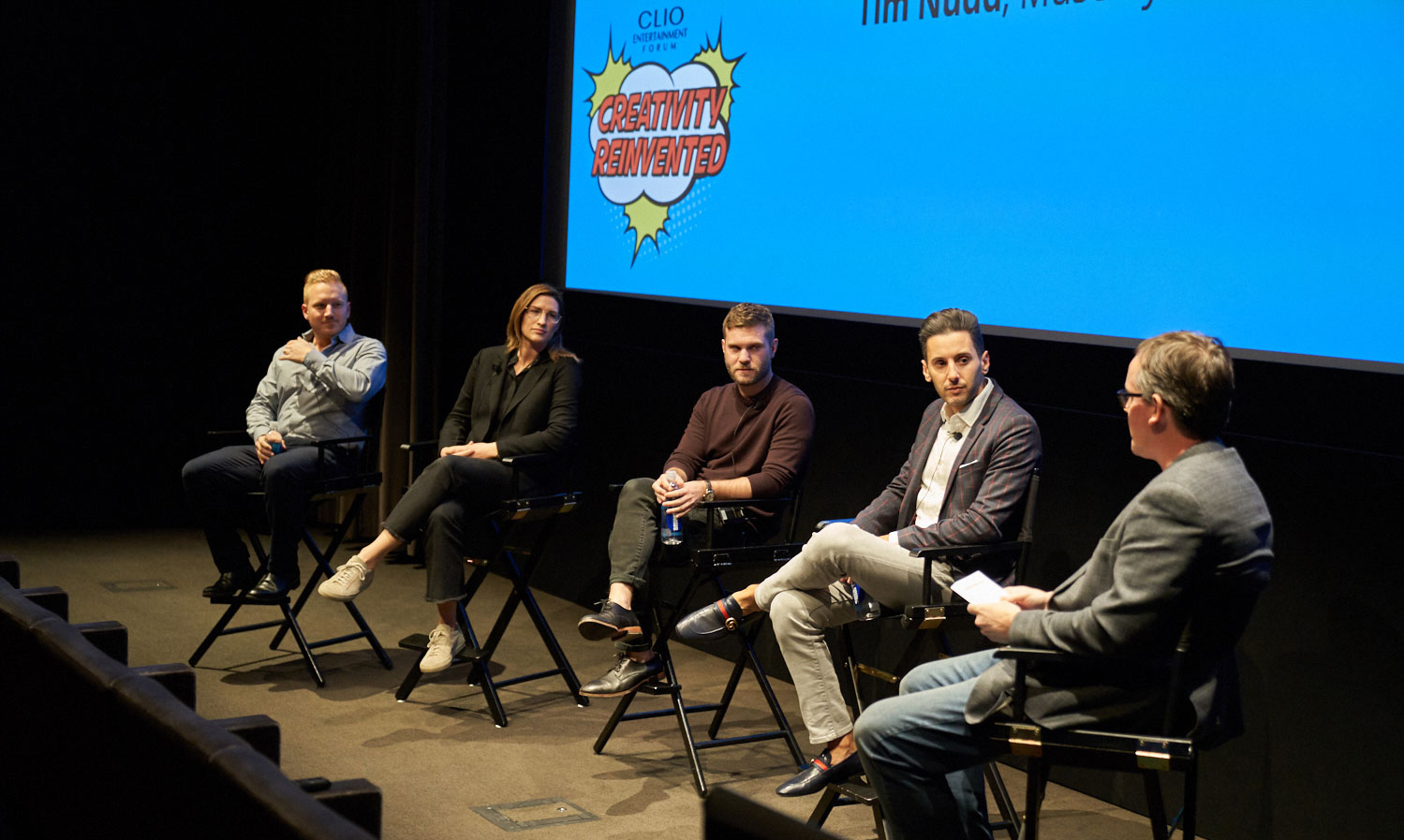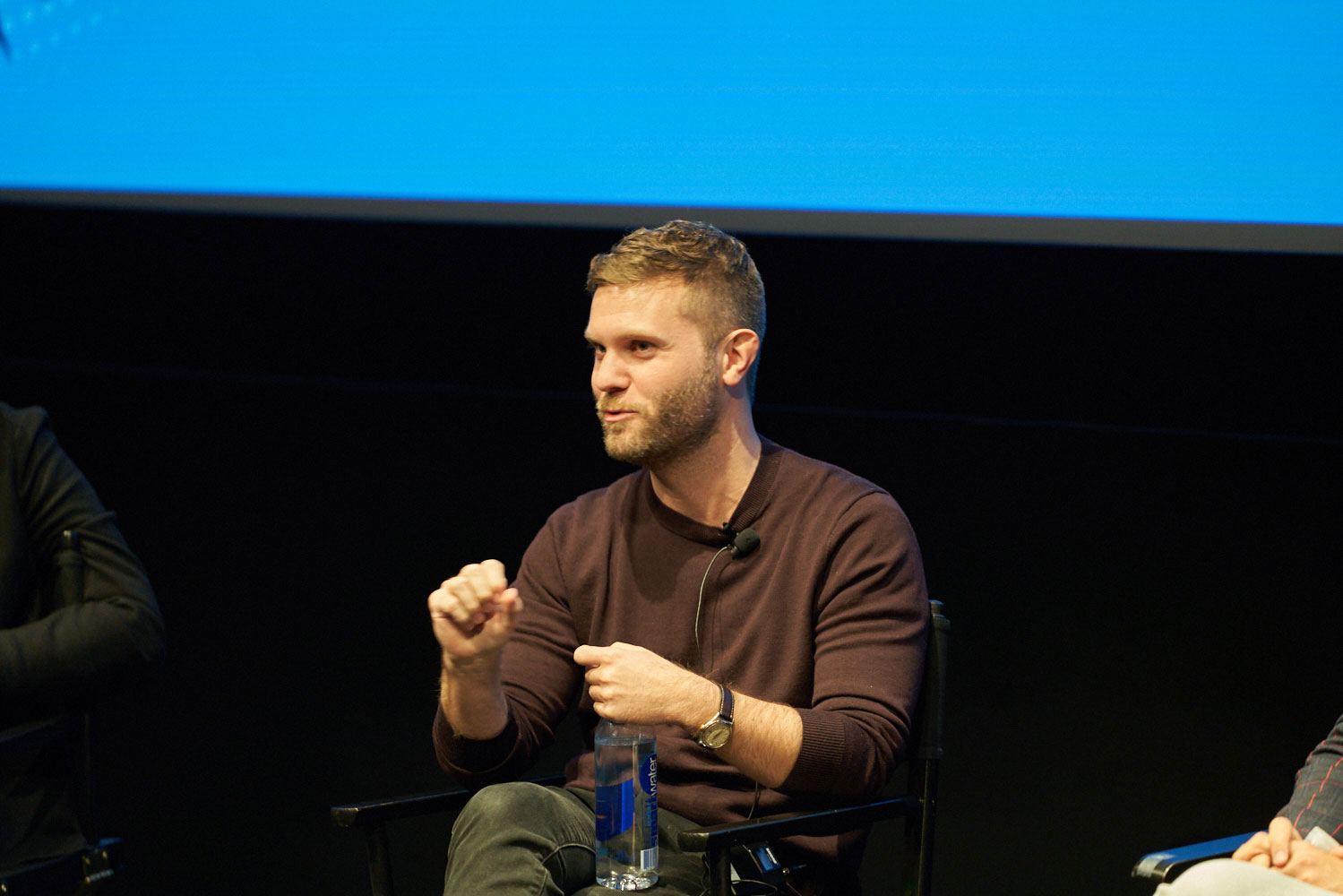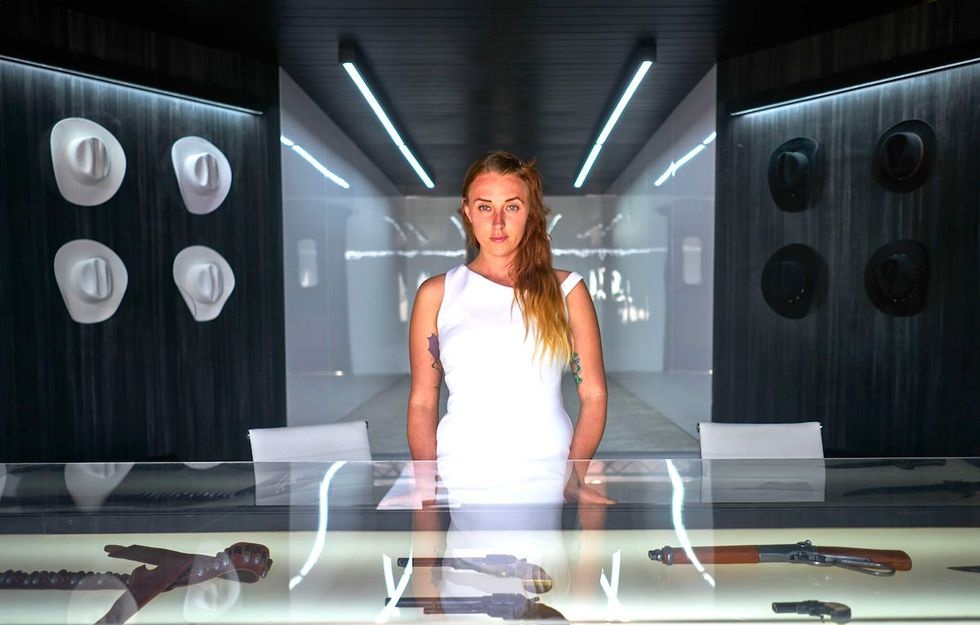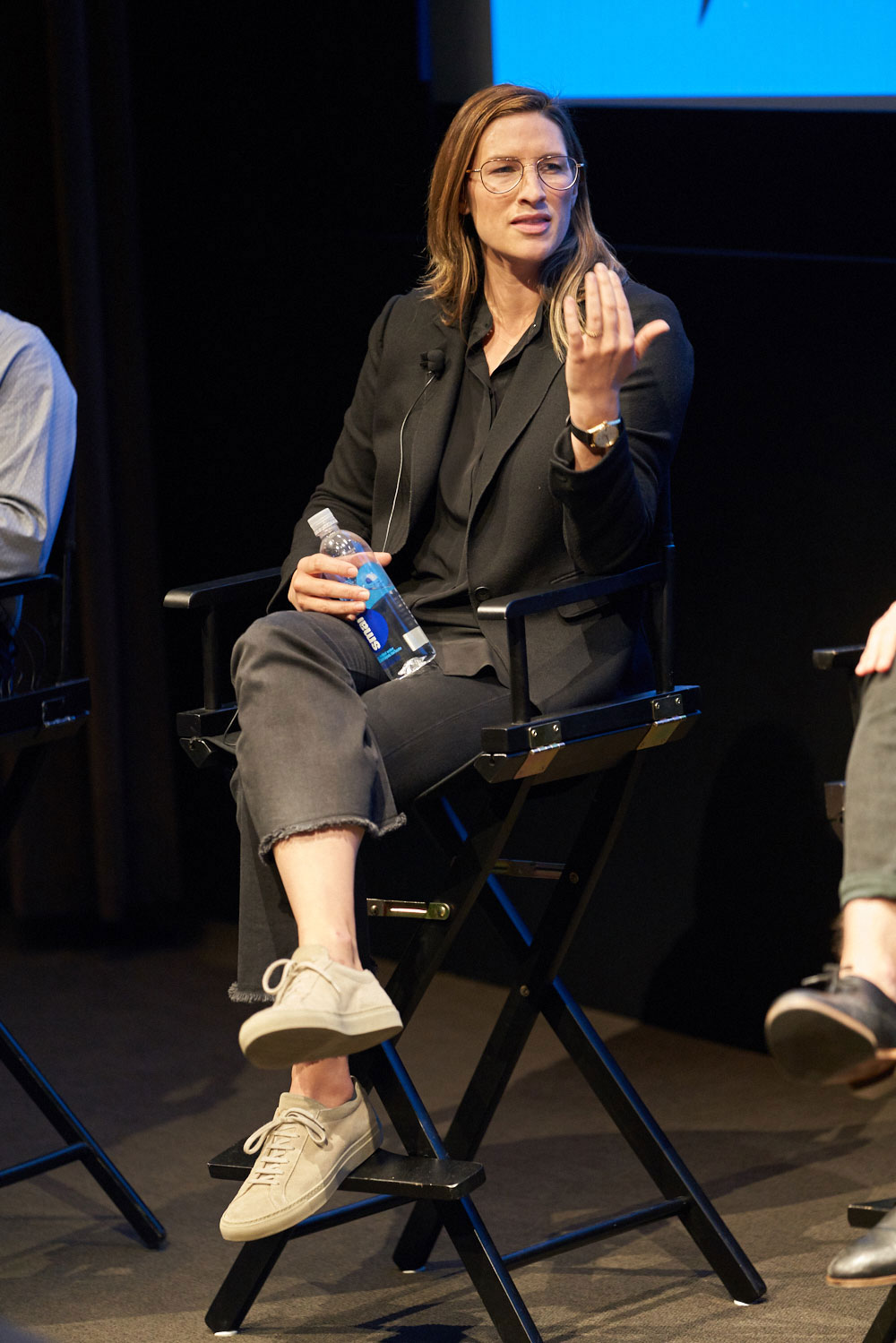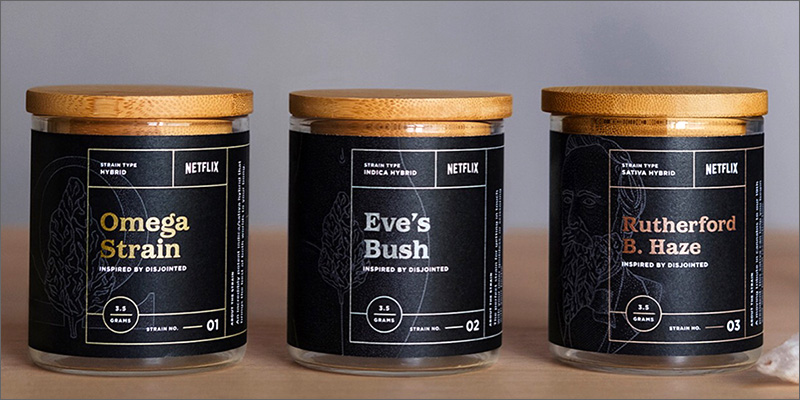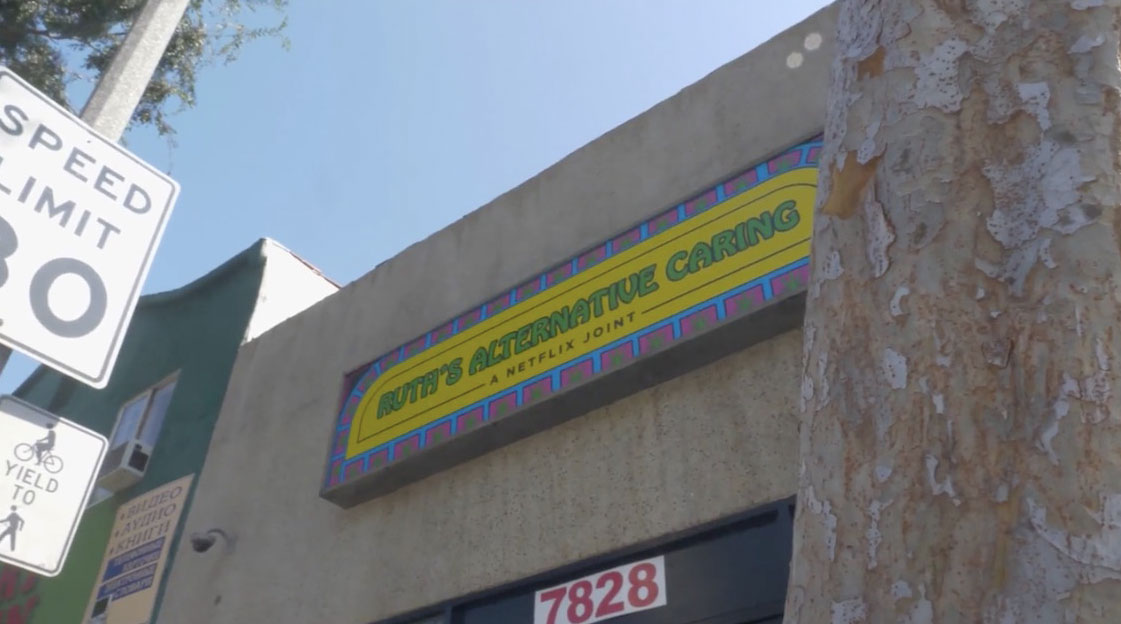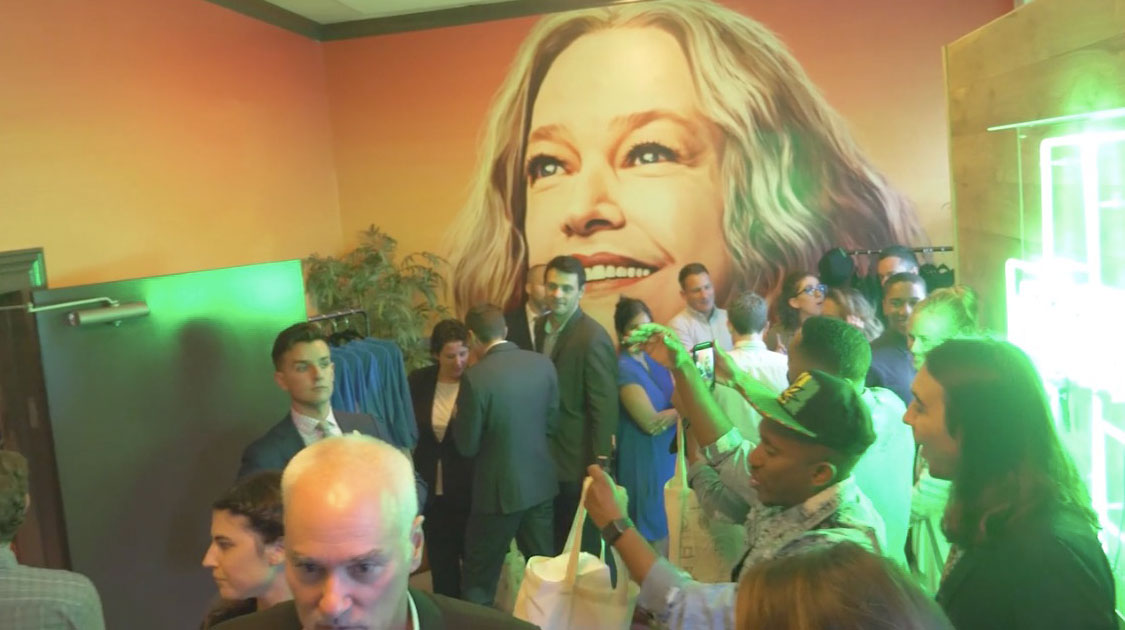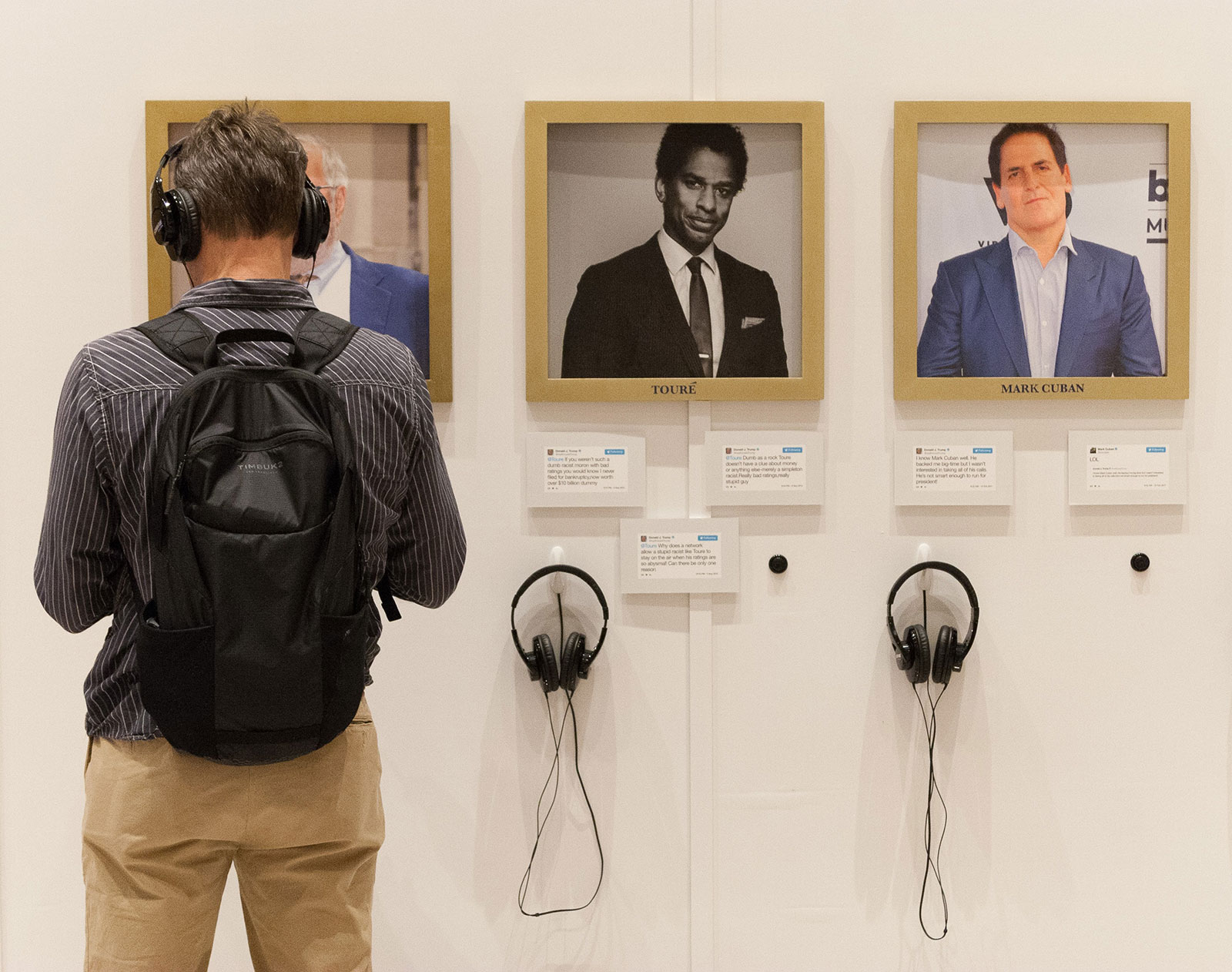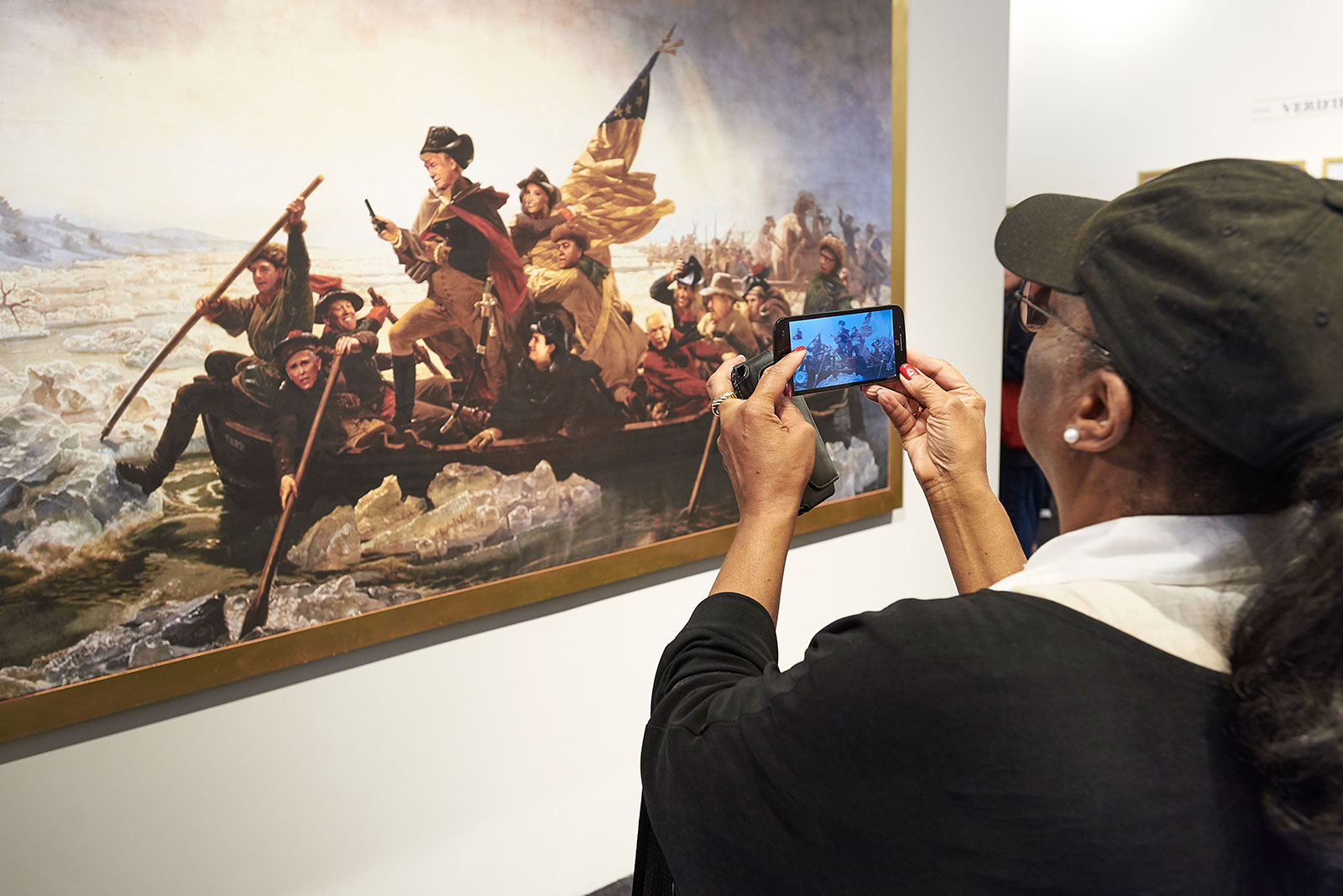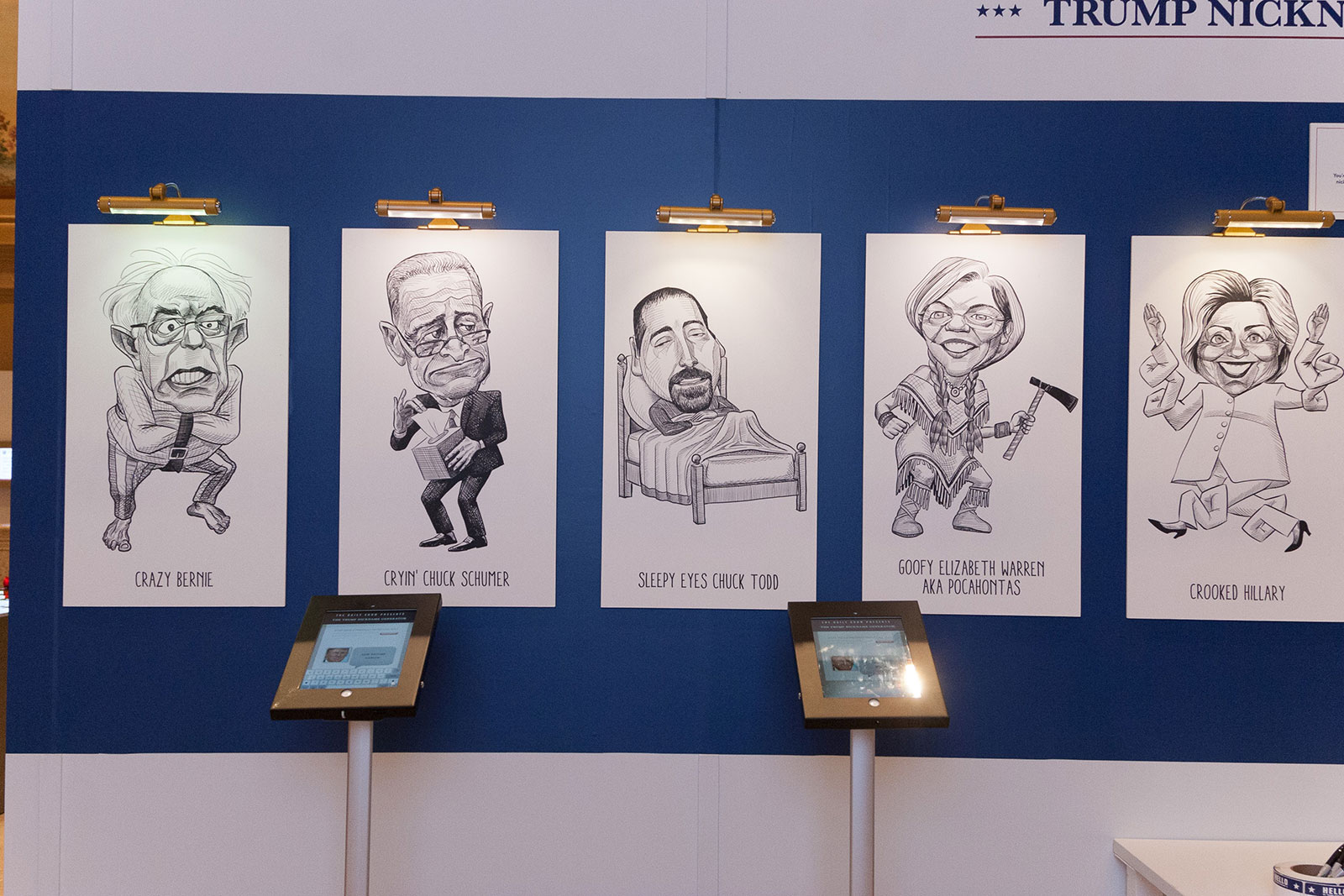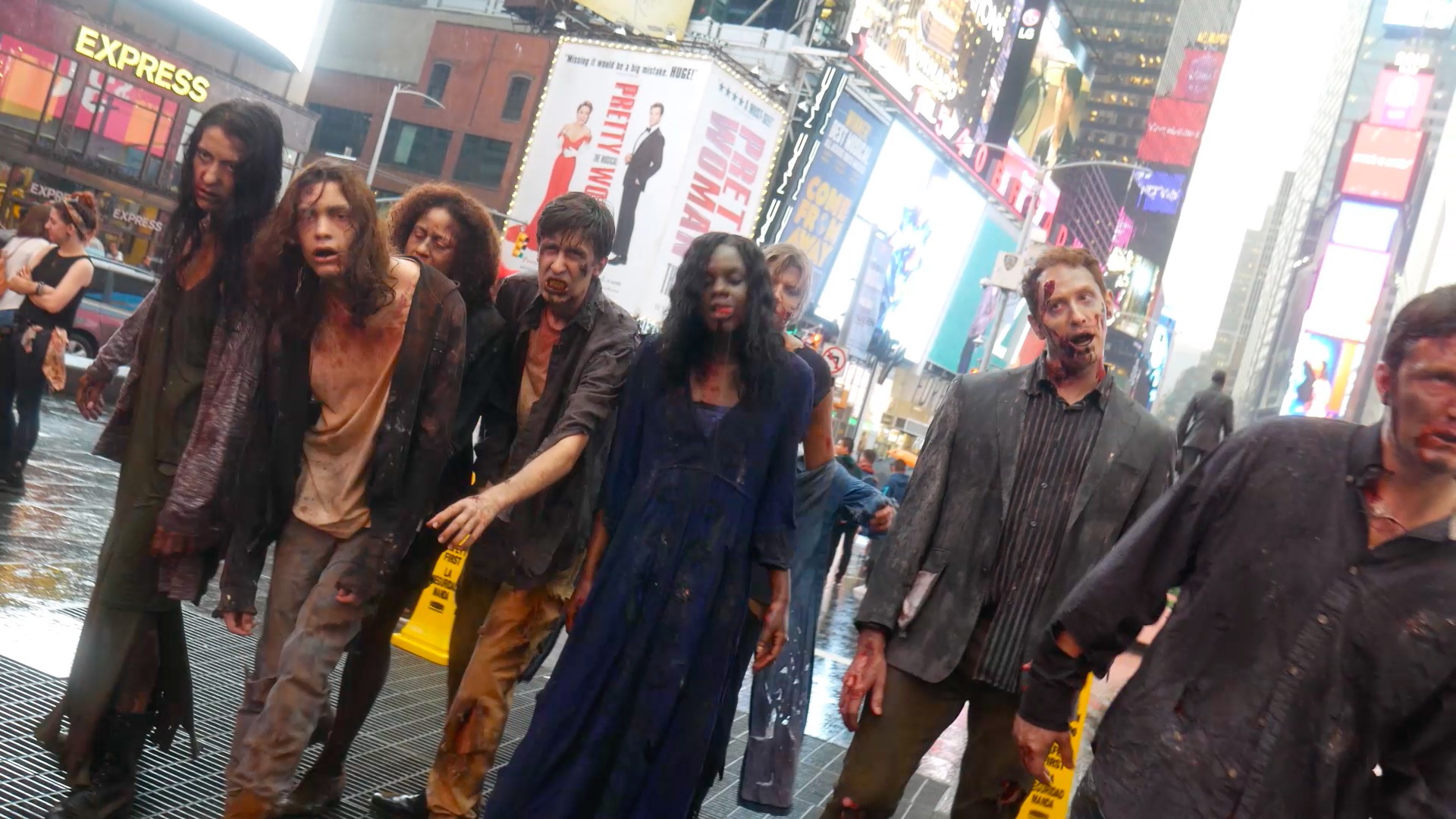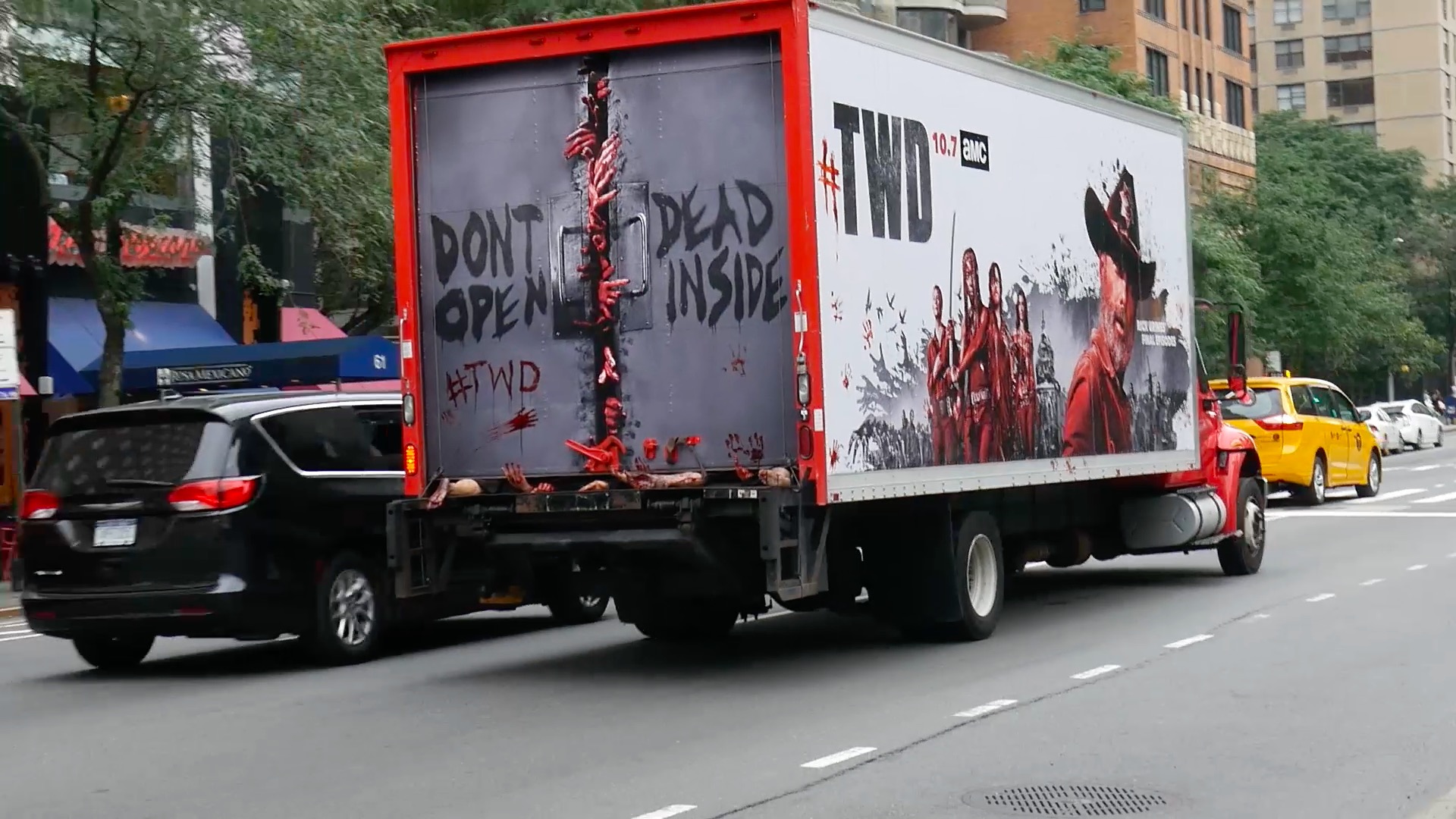Experiential is all the rage among marketers these days. But how do you choose when to try an experiential activation? How do you build it? And then, of course, how do you measure it?
A few weeks ago, Muse put those questions to a group of top creative marketing execs working in television, at the first-ever Clio Entertainment Forum in Los Angeles. The theme of the hourlong panel was "World Building: Bringing TV Shows Off the Screen and Into Fans' Lives." The four panelists were (from left):
• Justin Manfredi, SVP of Marketing, AMC Networks
• Monica Austin, Director of Global Creative and Social Marketing, Originals, Netflix
• Steven Cardwell, Director of Program Marketing and Marketing Strategy, HBO
• Shawn Silverman, SVP of Brand Marketing and Events, Comedy Central + Paramount Network + TV Land
Below, we've condensed some of their thoughts from the discussion, which touched on four campaigns specifically: "SXSWestworld" for HBO's Westworld; "Ruth's Alternative Caring" for Netflix's Disjointed; "The Donald J. Trump Presidential Twitter Library" for Comedy Central; and "Walkers in New York" for AMC's The Walking Dead.
What experiential can do that other marketing can't
• Justin Manfredi, AMC: It takes what we do, day in and day out, and brings it to life in a very real and tangible way that people can touch and feel. The content we produce has an incredible amount of fandom around it. To be able to bring that to fans on a day-to-day basis and have them interact with your shows, your properties, your franchises, I think is pretty pretty epic and amazing.
• Monica Austin, Netflix: It's become something where you can actually see its ROI more directly. The signals were always there, that fans want to engage with your content. They want to experience and touch and feel it and show their fandom through these experiences. But I think it's become more of a relevant tactic over the last couple of years, as we see social sharing and that behavior continue to grow. I think of it not as a must-have, but for the right property, for the right audience, it's a really strong tactic if you get it right.
• Steven Cardwell, HBO: An episode of TV is finite—it's 30 minutes, 60 minutes. There's a limited amount of time you have to tell a story. What I love about experiential is that you have an opportunity to extend a storyline, to explore something that the writers didn't have a chance to get to, especially when you're talking about shows with deep mythology. You have a lot more runway to immerse fans into the content and let them be a part of the show.
• Shawn Silverman, Comedy Central: My first project at Comedy Central years ago was bringing the town of South Park to life at Comic-Con. It's always been in our DNA. It's got to be the right brand at the right time at the right place. I also look at it as a reward for the fans.
How HBO made 'SXSWestworld'
• Steven Cardwell, HBO:
The idea
We wanted to replicate what it would be like to actually go to Westworld. It was a really good opportunity for us to approach it from the point of view of the marketers of the company that built Westworld, rather than HBO. We didn't have an HBO logo on anything. All the marketing for it was done in-world. We had out-of-home ads, TV spots running all over Austin, enticing people to come visit.
There's a temptation in experiential to lean into virtual reality, augmented reality, especially at a place like SXSW, which is built on tech. We wanted to take a completely opposite approach and do something without any tech. The most high-tech thing we had was a DVD player on the bus. Everything was human and personal, because that's what Westworld is. You're not supposed to be able to distinguish between the hosts and the machines. It felt like a natural integration, and I think that authenticity is why it was successful.
The experience
The fun thing was watching people experience it. There wasn't a guided tour. One of our hosts on the show says to William when he's arriving, "Half the fun of Westworld is figuring out how it works." That quote speaks to the idea that this was such a mindfuck of a social experiment. People took on a very voyeuristic attitude when they got into the park, but their guard went down and they started to realize they could have conversations with the actors. Fans of the show realized there was a lot of fertile ground that we were laying, Easter eggs and hints for what was coming up in the next season.
One of my favorite things was listening, on the bus rides back, to people comparing notes for what they did, structures they went into, people they talked to. Everyone had a completely different experience. We personalized letters for every person who entered the park. It sent them down a little rabbit hole for things to look out for, guests to talk to, that were teasing, tangentially, what was going on in the series itself.
We had hidden cameras all over the park, monitoring what people were doing. We couldn't get people to leave. We were expecting that we'd have turnaround every hour. But there were people that would stay for four or five hours because there was so much to do. You could get a shave at the barbershop, you could learn how to knife throw, you could have dinner at the restaurant and cocktails at the bar, play poker with the card sharks. On the last night, we actually had a couple ask if they could get married. So we had to stage a wedding on the last night.
We wanted to make sure this was accessible for someone who wasn't a fan of Westworld. It would give them a demonstration of what the show is. We had 66 actors in the script playing out a 90-minute narrative. But for fans—that hard-core Reddit audience—we had 20 clues buried throughout the park. Some quite literally. For those who know the show, the maze is what all the hosts are searching for in Season 1, and it's actually buried in Dolores' grave. We leaned a shovel against a barn. I assumed no one would actually start digging up a grave. But sure enough, by the end of the first hour, there were people digging.
The build
It was actually a ghost town that already existed. So it involved a lot of retrofitting. But of course, everything goes wrong when you start really getting into the nitty-gritty. It wasn't up to code, we had to install fire hydrants, we had to rewire all the electrics. This guy just built this as a hobby over the course of his life. So there were a lot of projects at the 11th hour. It all came together, but it was a very, very big build. We also had a big storm the weekend before. We were building on site for about a month, and it just turned into a complete mud pit.
It was an eight-month development process. We were very ingrained with the show, with the writers. When you're dealing with something so intricate, you can really mess things up if you get something wrong in the story or you're contradicting something that they have planned for Season 5. They were combing through every word of every script.
The agency
I cold-emailed [Giant Spoon, which built SXSWestworld]. They did a Blade Runner experience at San Diego Comic-Con. I was blown away with the scale of it. When I saw that the potential of really scaling what we wanted to do with Westworld, they seemed like the right partner. You get so many agencies that come in and pitch the wildest ideas, and you know they have no idea actually how to pull it off. I had a lot of trust in their abilities.
How Netflix made 'Ruth's Alternative Caring' for Disjointed
• Monica Austin, Netflix:
The idea
Talk about weird days at work, when you're pitching, "Hey, what if we do a dispensary and make lines of weed for our new show!?" Our CMO was like, "Hmm, tell me more!"
We had this interesting challenge of: How do you reach a traditional TV viewer with a sitcom by Chuck Lorre but with a really sensitive topic that is, outside of L.A. and New York and Colorado, not particularly embraced or mainstream. What we all agreed on was that traditional tactics weren't going to be the thing that was going to get attention. We said, "What if we took the bulk of our creative marketing budget and our media budget and put it into this experiential activation?"
The experience
Certainly just saying Netflix creates a dispensary is enough to drive a headline, but it doesn't really connect us to Disjointed and what we were trying to message. So it was really important to also bring in some of the other Netflix titles to give you that hook of authentic credibility to the show. That was probably the most fun, coming up with all the names of the strains. We didn't actually create the strains. We created the containers, and then Ruth's, the dispensary, put them in. But that was the impetus—let's drive to one event, one stunt, and really make sure the publicity, media, everybody's amplifying this, versus going in their own lanes. This was the big tactic for the campaign.
The store still looks fantastic. It's still on Melrose, you can go take a look. We kitted it out the same way as the show, so it felt a little premium, it had great imagery. We used a lot of the art from the show to make sure we were connecting the dots. We wanted to make sure it felt premium but it still felt authentic to being a dispensary that you would line up for to actually purchase medical marijuana, which you could do from this dispensary as well. We spent a lot of time on the details—wood paneling, leather couches, great imagery on the walls. We built all the neon signs. On the outside we replicated what it looked like on the show. We put the new sign up, and the new imagery in the window.
The challenges
No one expected the level of foot traffic. Normally this dispensary gets 50-60 people a day. We did 700-plus in two days. They ran out of money at the ATM. There were lines down the block. We did a Stranger Things partnership with Topshop in London—similar thing. I think you're never quite sure what the response is going to be. It was about overpreparing for the influx of people, from a security standpoint, from an operations standpoint, with police and permits and things like that. It was pretty overwhelming for the shop—purely the volume of people that we got through.
We could've named all the lines based on show characters, made it super in-world. But that's really why we wanted to make sure we were bringing in the rest of your favorite Netflix shows: Banana Stand Kush from Arrested Development, Poussey Riot from Orange Is the New Black. We felt like that was going to give that bigger nod-and-wink to get existing fans from shows that we thought aligned with this. Get them in there, get them exciting about it, get them talking about it. In hindsight, we probably would've leveraged that just a touch more and done just a bit more cross-pollinating with those accounts and those fandoms. We tried to be delicate about that, because you have to be careful when overpromoting a new show through an existing base, but I think we probably could've done a little bit more there.
How Comedy Central made 'The Donald J. Trump Presidential Twitter Library' for The Daily Show
• Shawn Silverman, Comedy Central:
The idea
My rule of thumb is, if I'm worried I'm going to get fired or arrested for a project, it's probably going to be pretty big. This one had the added benefit of worrying: Am I also going to have my tax returns audited?
The show had a kernel of an idea: He doesn't read. What's his library going to look like? Let's build it with his tweets. We worked closely with them and one of our third-party partners to visualize what that experience would look like. You can't just print tweets everywhere and expect everyone to read hundreds and hundreds and hundreds of tweets. We had to turn some of them into experiences, some of them into photo ops, some of them into 3-D builds.
The experience
The library's a mixture of things to read, things to feel. You could actually get dressed up. We rebuilt the Oval Office, and there was a interactive experience where you'd be given a challenge. You had a very short window of time to pull together a tweet. You dress up in a presidential robe. You sit on a golden throne, because there's theories of what time those tweets normally happen. And then you've got to fire off this tweet in the spirit of what we typically see at 5 in the morning on our Twitter feeds.
For this to be a presidential library, we certainly had to aesthetic the caliber of it. We took painful, painful detail in trying to find venues that would feel presidential. We couldn't just put this in an empty storefront. The one in New York, which is where we kicked it off, literally was catty-corner from Trump Tower. In fact, one of his sons walked by opening night, and we invited him in to skip the line. But he chose not to.
Scaling the experience
It started in New York. And based on the overwhelming success we had—people waiting in line for seven and a half hours to get in—we then went in Chicago, San Francisco. We were in Los Angeles for two weekends that overlapped. We were in West Hollywood overlapped with Pride Parade, so that was an entertaining week and a half. And then, most recently, in Miami. And more places to come.
In Miami, [Trump] fired off a tweetstorm as soon as the library opened up, so we like to think that he's a little bit aware [of the library]. But I don't think he's acknowledged it yet.
One of the unintended outcomes of the Daily Show library was there's actually a physical book now that you can buy on Amazon, it's on The New York Times bestseller list. So we're generating revenue for the company now from this marketing stunt that was never part of our initial goals. Once we saw the demand for it, we were able to seize on that.
How AMC made 'Walkers in New York' for The Walking Dead
• Justin Manfredi, AMC:
The idea
We had a big panel at New York Comic-Con, as we often do, and we were holding it at Madison Square Garden for about 5,000 fans. The panel was on Oct. 6. Our premier was Sunday, Oct. 7. So we started to work backward and say, "OK, what could we do to ignite more passionate fandom around not only the franchise but specifically around this beginning episode of the season?" And so a couple weeks before, someone said, "Why don't we just take over New York? Let's just unleash walkers everywhere." I was like, "OK, I can see a lot that can go wrong with that, for various reasons." But we started to wrap our heads around what that might look like. And we said, "Fans love this. Everyone's about that Instagrammable moment. How can we have a surprise-and-delight on a big mass scale?"
There were multiple trucks moving around New York for the three days leading up to our panel. On more than one occasion, the fine men and women of the New York Police Department reached out to us. What's funny, though, is that the one instance I had with them was in front of my own building, where AMC Networks is headquartered. There's like six police officers with K-9 dogs and horses walking towards me. They pick me out and are like "Can I talk to you?" And I was like, "Yeah, what's up?" And they said, "Can we just get some pictures!?"
The experience
As much as it was an activation and an event, it was also a way to collect data. All 5,000 people who came into the theater at MSG were strongly encouraged to opt into our CRM and data plan. There were giveaways, there were carrots to give people an incentive to fork over some data. We're not talking bank accounts and social security numbers, but email, name. At the risk of sounding super creepy, we now have all this data on people that we can then retarget, and remarket, and follow them around their social graph and so forth. But it actually allowed us to identify the corest of the core fans, who we call our "blue whales," who are the biggest advocates. And if we can spark that Reddit community, that's becomes the tenfold amplifier out to the rest of the world.
The last piece of it was, the night we drove everyone to this panel, they listened to all our stars, there was meet and greets, and then, when the panel was over at 9 o'clock at night, they thought they were getting up to go home. Chris Hardwick came out and said, "Why don't you just stick around and watch the first episode 24 hours early?" So this is about rewarding the fans. That's really important. We get caught up in our own marketing sometimes, and it's about what are you giving back and what are you doing for the fans?
How to measure experiential
• Steven Cardwell, HBO: It's really impossible to measure. Everyone is always touting, "Oh, it received a billion impressions." What the hell does that mean? The biggest metric for us is FOMO. You're creating a moment that only a very exclusive amount of people get to experience, and it just scales so big. There's a huge trend now in museum Instagrammable experiences. It's about creating experiences that people want to share. But in the case of Westworld, it wasn't like a photo booth. The whole thing was meant to be livestreamed and Instagrammed. It was a "You had to be there" moment. Everyone got a white hat or a black hat, based on a personality test. Seeing those hats dotted all around Austin through the weekend, it was like a badge of honor. You got to go to Westworld. FOMO was huge. Don't underestimate it.
• Monica Austin, Netflix: In the case of Disjointed, we were really looking at earned media and publicity. We didn't think the social volume from a small amount of L.A. consumers was really going to be the zeitgeist piercer. We knew the media coverage was going to do that for us. So we looked at benchmarks of new shows, similar budget, what type of coverage do we normally see? And what would our goal be for something like this? That's how we aligned our KPIs and ROI for this activation.
We apply that with different goals and different metrics, depending on what the activation is. Some things are truly for the fans. If it's something like Stranger Things, obviously you're going to be looking at social volume and fan sentiment. We try to back into the goals based on benchmarks and historical performance. As we do more and more of these events and activations, it's getting a little bit easier for us to determine. Is this the right place to spend our money? Can we really get out of it what we need to for this campaign? Or are we better placed putting this into media or another tactic?
• Shawn Silverman, Comedy Central: The marketing campaign, at the end of the day, has to do a lot of the heavy lifting. That's the spot and dots, the true paid media. The experiential stuff comes down to: Are you doing it to try to generate press and get earned media out of it? Or are you doing it to collect data to retarget people? Or are you just doing it to reward fans? The perfect experiential thing will do all three. They might not necessarily always do all three, though.
Sometimes I think on-the-ground data can be really hard to wrap your head around—whether it was worth all the time, energy and cost. The social echo is an important piece of it. Instagrammable moments, shareable moments. Is it reverberating beyond the ground, so that people are talking about it? Now that we've done the library in multiple cities, we have our own cost analysis. Bringing the library costs X amount of dollars. How much earned media do we get out of that, versus if we spent that exact same amount of money buying a TV ad or a billboard in that market?
• Monica Austin, Netflix: The other piece to that is just the media coverage in that earned media moment. For Disjointed, it was: Can we get more headlines for this new show from this event than if we were just pitching out for reviews? The goal with this was to go beyond what we thought we would get with the traditional publicity tactics.
• Justin Manfredi, AMC: One of the things I say to my team when we're brainstorming ideas is: How do you take—if it's something as big as SXSW or San Diego Comic-Con, or something on a smaller scale like MSG—how do you make an event that the whole world can share in, and not just the 5,000 people who go through your activation? Because you'll never be ROI-positive at that rate. There are so many hooks and amplification methods. Using social, Facebook Live, which we did when we premiered the first episode. Finding a way for the person in middle America who's not in New York City, who didn't get to meet a walker, how do they get to experience that?
• Steven Cardwell, HBO: One other metric is engagement. In traditional media, we're looking for someone to watch a Facebook ad for three seconds. But with experiential, someone can spend three hours inside a property. That impression is just so much more significant than any traditional media buy could do.
What not to do in experiential
• Steven Cardwell, HBO: I've had so many people come to me and say, "What's the 29Rooms version of ... ?" There's fads. With the Museum of Ice Cream and 29Rooms, what are we really providing other than just an Instagrammable moment?
• Monica Austin, Netflix: I think it's about the authenticity. There's so much derivative experiential. "This will work because I'll mash it up with my version of it, and it's going to have the same level of impact." You often see it on a campaign plan—there will be experiential. But it really has to be authentic to the campaign goals, the franchise, the title, the audience. Especially experiential needs to have an authentic core versus "Oh, I'm just going to add this on because it will round out my media mix." I hear a lot of that, too. What's our version of X, Y, Z. That's the wrong way when it comes to experiential.
• Shawn Silverman, Comedy Central: The lens we put everything through is: If you took the logo off this, could any show or brand replicate it and just stamp their logo on it? And if that's the case, then it's probably not worth doing. The authenticity piece is critical. There are only certain things that South Park can do because they're South Park. If any other show on air could do the exact same thing by just swapping out the logo, then it's not something we're going to pursue.
The advice I give is: Never plan exactly to budget, because there will always be last-minute things that come up. And beyond that, think long term. The team spends so much time building these things, and then they get torn down after three days in San Diego. What are you doing with this stuff? We have storage facilities all over the country now—in Austin, and San Diego, and New York—because we plan on repurposing this stuff. You could use some of it again in future events, even if you're not doing the same exact thing. To spend all this time, energy, and money building it, and then trash it, is just kind of silly.
And then the other thing I would say, in our experience, is bring legal in early and get their approval and blessing on everything.
• Justin Manfredi, AMC: Plan for all the shit that can go wrong, because it will, not just executionally but in the world. We live in a crazy world, and you can imagine having semi-dead people or people rising from the dead walking around the streets of New York. There's a lot that can be taken the wrong way. Or you wake up that morning, something happens in the news, and all of a sudden it's in really poor taste.
• Shawn Silverman, Comedy Central: I can give a real-time concrete example of that. We did The Daily Show library in Miami a few weeks ago, and we did it at a venue on Miami Beach that was attached to a synagogue. And sadly, that was the same weekend as the Pittsburgh shooting at the synagogue. We beefed up security immediately. We had to react to that immediately and make sure that we were prepared, given what was going on in the world around us that we had no control over.
What's next for experiential
• Steve Cardwell, HBO: I think the signal that we've all received is that we all really crave tangible things. We're so plugged into our phones that anything that we can get people to do to look up, and actually take something in, in real life, I think there's huge value in that. I think what SXSW did for us was just really prove there's value in reality and real experiences in such a digital world.
• Monica Austin, Netflix: It's an interesting new challenge, that idea of oversaturation and overdependence on digital. I'm excited about the next wave of that—turn your phone off when you go in here—as an interesting hook. We're talking about things in that space for a couple of our franchises, because the point is, go in and experience it and be with your friends and have a moment where you don't feel like you have to be capturing and collecting. But I do think, then it's on us, because how do we measure that? You're not going to have that volume trigger. Maybe it's in sign-ups, maybe it's in tickets, maybe it's in other things. But I think there is a wave of that happening.
Interested in attending, sponsoring or speaking at one of Clio’s future Forums? Email caitlin.mclaughlin@clioawards.com today.

